Top 5 significant archaeological discoveries of 2013 in Henan Province
From:Chinese Archaeology NetWriter:Date:2014-03-18
The results of Henan Province’s top 5 archaeological discoveries in 2013 has been announced in Zhengzhou, including the 8th excavation of Wuyang Jiahu Neolithic site, the relics of Hangu Pass dating back to Han dynasty in Xin’an County, the No. 4 building remains of the Palace in ancient Luoyang city during Han and Wei dynasties, the cemetery from the Northern Wei period in Hengshan Road, Luoyang and the relics of a Jun kiln at Jianye JunduXintiandi in Shenhou, Yuzhou.
These are selected from 10 nominations by the panel in annual contest of Henan’s top 5 finds which has been organized by Henan Provincial Bureau of Cultural Relics and jointly undertaken by Henan Cultural Relics and Archaeology Association and Chinese academic journal Huaxia Archaeology since 6 years ago.
The finally selected top 5 finds range widely in date from the Neolithic period (more than 8000 years ago) to Ming dynasty (about 600 years ago). Among them, Wuyang Jiahu Neolithic site has been carried out for 8 excavated seasons and the relics of Jianye JunduXintiandi Jun Kiln relics in Shenhou, Yuzhou are unearthed for the 4th time. However, both of them have new discoveries of great archaeological value.
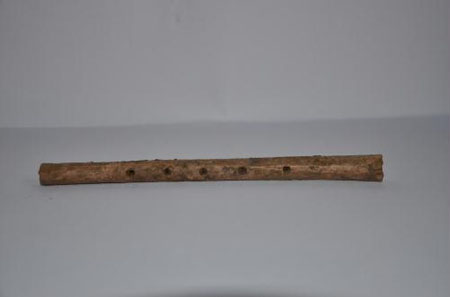
bone flute unearthed from Jiahu site
1. New discoveries in Jiahu site
As a site dating to Peiligang cultural period with the biggest excavated area and richest finds, Jiahu Neolithic site is of quite high historical and scientific values. In memory of its 1st excavation 30 years ago, the 8th season was taken out jointly by Henan Institute of Cultural Relics and Archaeology and China Science and Technology University with the permission of State Administration of Cultural Relics from September to December in 2013.
Abundant artifacts were unearthed during this season, including bone flutes, bone folk-shaped artifacts, turtle shells as well as many new finds. For example, the first appearance of more than 1200 turquoise ornaments in northwestern part of the excavation area predicts the existence of certain differentiations in the layout and hierarchy of the cemetery. What’s more, the exquisitely made ivory engravings with the design of Chinese character “中” are very rare in the Neolithic sites. All of these achievements not only deepen the understanding of Jiahu culture, but also provide new materials for the discussion of human culture and social structure in Neolithic period, Huaihe River.
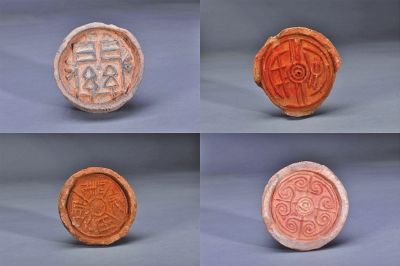
Tile-end unearthed from Hangu Pass
2. The first appearance of Hangu Pass’s city in Han dynasty
As the first pass of ancient Luoyang’s eight great passes, Hangu Pass in Han dynasty dating back 2100 years ago was always an important part of the defense system for Luoyang basin and surrounding areas. In order to cope with the application for the lists of world cultural heritage, survey and excavation of Hangu Pass ruins has been formally carried out from June, 2012 to August, 2013.
As a long and narrow town of a small scale, walls, roads and remains of buildings and etc. were discovered. Located between the gorges, the east wall of the Pass city connected with rammed earth walls on the mountains in the north and south sides so as to act as military defense and traffic fort. The ancient road going through the Pass in east-west direction was the only route to pass through. Besides, the northern bank of Zaojian River and the southern part of the site was main living place at that time.
The discovery of Hangu Pass is of high academic value, providing vital materials for the research of passes in Qin and Han Dynasties and significant evidences for the protection of Hangu Pass ruins as well as Silk Road’s application for the world cultural heritage status.
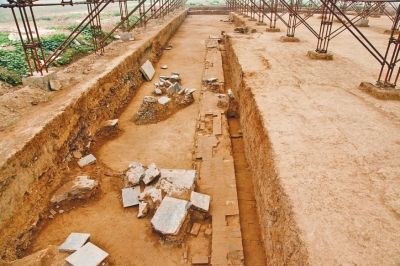
Northern part of the excavation area in ancient Luoyang city
3. Taiji Palace found in ancient Luoyang city in Han-Wei period
As a national capital of over 540 years, Luoyang city from Han dynasty to Wei dynasty is an ancient Chinese city with the longest time as a capital, the largest scale and relatively complete preservation state.
Overall survey and excavation of Han-Wei Luoyang city has been taken out by Institute of Archaeology, Chinese Academy of Social Sciences (IA CASS) to the demand of national conservation of great sites. A sloping terrace high in the center and low all around with a 3m difference of height was found slightly northwest to the center of the palace and named the No.4 building ruins of ancient Luoyang city of Han and Wei dynasties.
According to the survey, together with the No.3 building in the southern part of the Palace, the No.2 building and the southern gate Changhemen gate, the No.4 building was on the same building axis. As the largest one of them, it was the central building of the capital which was the Taiji Palace in history documents. Subsidiary building in its eastern side might be the East Hall of Taiji Palace in historic records. The excavation of the No.4 building ruins enriches information of Taiji Palace in Han-Wei Luoyang city in terms of its location, size, layout, state of preservation and so on. The design concept and palace system have important meaning in the research of Han-Wei Luoyang city as well as systems of Chinese ancient capital cities.
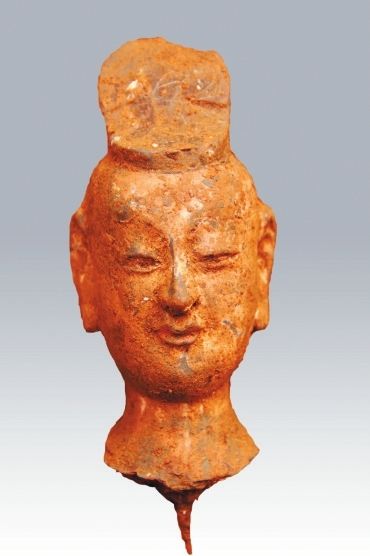
figurine head unearthed from the cemetery in Hengshan Road, Luoyang
4. Northern Wei period cemetery in Hengshan Road, Luoyang might be a mausoleum of an emperor.
A relatively large scale ancient cemetery was found in the north end of Hengshan Road, Luoyang city by Luoyang Institute of Cultural Relics and Archaeology. According to archaeological excavation and historical materials, this cemetery was preliminarily concluded to be a mausoleum of an emperor and its master might be Emperor Jiemin of the Northern Wei dynasty, whose personal name was Yuan Gong(元恭).
The mausoleum was looted for several times. While a relatively small amount of artifacts were found, ranging from pottery, green porcelain, bronze artifacts, a gold coin and stone building elements as well as the remains of warriors figurines and tomb guardian breasts, all have suffered damage. Among them, a gold coin minted during the reign of Anastasius I who was the Byzantine Emperor during the period 491-518 AD showed the time of the tomb would be no sooner than the time when Luoyang was chosen to be the Capital of the Northern Wei.
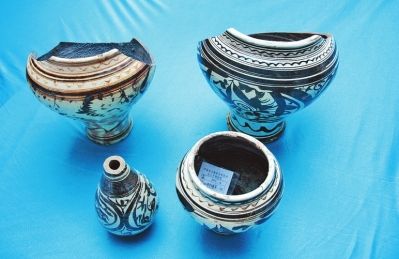
porcelain pots with black decorations against white ground from Ming dynasty at Jun Kiln, Shenhou, Henan province
5. Jun kiln from Ming Dynasty found in Shenhou
Shenhou town located in 30 km southwest of Yuzhou which is a significant homeland of Jun porcelain had been developed gradually since Tang dynasty and had become a porcelain production center in Northern China during Song and Jin periods. Salvage excavation was carried out by Henan Institute of Cultural Relics and Archaeology coping with the infrastructure in March, 2013.
Several porcelain kilns as well as a great amount of shards and porcelain of various kinds from Jin, Yuan and Ming dynasties were cleared during the excavation. The total number is about tens of thousands including more than 800 restored wares. These kilns are first discovered in archaeological excavation history of Henan ancient porcelain kilns in terms of their great quantity, large scale and intensive distributions, let alone a number of kilns with exact date and lots of porcelain with black decorations against white ground from Ming dynasty. The finds lasting for 4 dynasties, including Song, Jin, Yuan and Ming dynasties, have greatly enhanced the research contents. (Translator: Ma Huanhuan)

